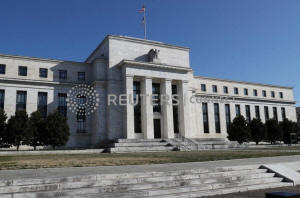Take Five: Take it easy, central banks - World markets
themes for the week ahead
 Send a link to a friend
Send a link to a friend
 [March 23, 2019]
(Reuters) - Following are five big themes
likely to dominate thinking of investors and traders in the coming week
and the Reuters stories related to them. [March 23, 2019]
(Reuters) - Following are five big themes
likely to dominate thinking of investors and traders in the coming week
and the Reuters stories related to them.
1/ TAKE IT EASY
With the U.S. Federal Reserve well and truly doubling down on its dovish
guidance this month, the global rate hiking cycle is at an end. There
are exceptions of course but the big central banks of the developed
world -- the Fed, the European Central Bank and Bank of Japan -- have
all reacted decisively to the steady drumbeat of depressing economic
data by pushing any policy tightening plans to the backburner.
But instead of deriving any comfort from the pivot, some in the market
are interpreting the moves as desperate measures to ward off impending
recession. That fear is certainly evident on bond markets where the gap
between three-month and 10-year U.S. treasury yields -- one of the
gauges the Fed uses to assess inflation risks -- has inverted. European
yield curves too have flattened and German 10-year government borrowing
costs have slid back below zero percent for the first time since 2016.

There are outliers. Norway has hiked rates while Hungary and Czech rates
may also rise this coming week. One could argue Norway's economy has
been lifted by oil this year, while emerging European economies have
been recovering nicely. But the question is: with the world's biggest
economy starting to hurt, Fed rate cuts bring priced for 2020 and G4
bond yields plunging, can any market avoid being sucked in? On
Wednesday, New Zealand's central bank could become the latest to flag
downside risks to growth and interest rates.
2/ DEADLINES, RED LINES
March 29 is when Britain was supposed to leave the European Union,
2-1/2-years after a slender majority voted to leave the bloc. EU leaders
have now granted Prime Minister Theresa May a two-week reprieve, during
which she must persuade lawmakers to accept the divorce deal she has
negotiated. Not easy, given they have resoundingly defeated it twice
already. She is expected to make another attempt and if the deal still
fails, several possibilities open up, from a no-deal Brexit to
Brextension and even exit from Brexit.
The question is whether May will be flexible on any of the "red lines"
she outlined in 2016, ruling out a customs union with the EU, UK's
membership of the single market and any role for the European court of
justice. Seen by many as an extreme interpretation of the referendum, it
has stymied efforts to find a solution to the Northern Ireland border
issue.
With all this in play, many warn that markets are still assigning too
low a probability to a no-deal Brexit -- banks such as Goldman Sachs and
Deutsche reckon that risk at just 15-20 percent. But though this is
rising, most analysts warn.

Sterling has tumbled this month after strengthening for two months
straight and jitters are bubbling up on derivative markets. Here
one-month pound risk reversals show an elevated premium for sterling
puts -- options that confer the right to sell at a certain price.
Implied sterling volatility -- a gauge of expected daily swings -- has
slipped off highs but remain above some typically volatile emerging
currencies such as Brazil's real or the Turkish lira.
3/ GLASS QUARTER FULL
Back in January, the U.S. Federal Reserve fired up investors' appetite
for risk by pledging to be patient with future rate rises. In March it
sealed that promise by doubling down on its dovish stance and scaling
back projected 2019 interest-rate increases to zero. The result: a 10
percent-plus bounce on global stocks in the January-March period. The
S&P500 is headed for its best first quarter of any year since 1991.
Other big Q1 winners with dollar-based gains close to 30 percent are
Chinese shares and Brent crude.
[to top of second column] |

Federal Reserve Board building on Constitution Avenue is pictured in
Washington, U.S., March 19, 2019. REUTERS/Leah Millis

What happens next? To some, the rally in what are inherently risky,
growth-reliant assets makes little sense when the world economy is in slowdown
mode and should therefore evaporate. But others counter the second quarter will
bring more gains. They note that despite double-digit gains, investors have
mostly been betting against stocks for most of 2019. Investment research firm
TrimTabs says equity funds have seen outflows of $18.7 billion this year through
Wednesday. They have instead channeled $73.1. billion into bond funds.
(Graphic: S&P 500 vs U.S.10-Year Treasury Yield link: https://tmsnrt.rs/2UNzRFP).
(Graphic: Q1 performance link: https://tmsnrt.rs/2UQo3CG).
4/EURO GLOOM TO BOOM -- OR DOOM
Despite a strong rally across markets this year, European equities remain one
of the most disliked regions in the world. Bank of America Merrill Lynch's
monthly fund manager survey confirmed that view, with investors naming "short"
European equities as the most crowded trade for the first time.
For contrarians, that's a gift - a sign bearish positioning on Europe has got
too extreme and stocks should rise from here.
Indeed, there are some positive signals from recent macroeconomic data, from
retail sales to wages. That has sparked a quiet rise on Citi's index of euro
zone macro surprises which now, interestingly, sits above the equivalent U.S.
index. There are also predictions that as China's economy starts benefiting from
the stimulus its authorities have unveiled, Europe too will feel the effect.

But after every glimmer of hope, comes a dampener. February PMI data from
Germany and the euro zone sent markets reeling.. Next up are the Ifo business
climate survey and consumer confidence figures. Those should tell us whether it
is too early to call a bottom.
5/YUAN: STRONG AND STABLE
Chinese markets aren't abandoning hopes that authorities may soon relax trading
rules for the yuan. Beijing and Washington are locked in heated discussions on a
deal to end their trade war and President Donald Trump hopes to extract a
commitment to yuan stability. The Chinese have other compulsions. The yuan fell
more than 5 percent in 2018 but this year it is rising too rapidly for comfort.
As China makes its way into global benchmark stock and bond indices, foreigners
are rushing into its markets. In January and February, inflows under the Stock
Connect scheme were almost quadruple the amount last year.
Rumors are swirling that China's currency regulator SAFE will rescind
requirements for banks to maintain reserves on dollar purchase contracts and
also remove the secretive X-factor used to guide the currency's trading range.
Theoretically, those steps would count as efforts to free the yuan - they were
imposed last year to curtail speculators betting against the yuan. Detractors
might say China is creating conditions for yuan depreciation. The coming week
should offer some visibility as a U.S. trade delegation, headed by Trade
Representative Robert Lighthizer and Treasury Secretary Steven Mnuchin, shows up
in China for the next round of tariff negotiations.
(Reporting by Karin Strohecker, Saikat Chatterjee and Helen Reid in London;
Jennifer Ablan in New York and Vidya Ranganathan in Singapore; Compiled by
Sujata Rao; Editing by Alison Williams)
[© 2019 Thomson Reuters. All rights
reserved.] Copyright 2019 Reuters. All rights reserved. This material may not be published,
broadcast, rewritten or redistributed.
Thompson Reuters is solely responsible for this content.
 |